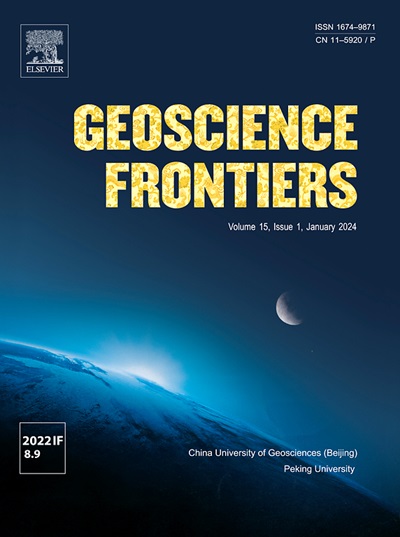Causal mechanisms and governance priorities of the SDG-based resource-economy-environment nexus in the human-nature system
IF 8.9
1区 地球科学
Q1 GEOSCIENCES, MULTIDISCIPLINARY
引用次数: 0
Abstract
The eight Sustainable Development Goals (SDGs) related to resources (2, 6, 7), economy (8, 9), and environment (12, 13, 15), collectively known as REE, form the core of the human-nature system. Understanding their complex interactions is crucial for identifying transformative and effective governance actions. However, the causal mechanisms underlying the REE-related SDGs remain elusive. We used expert elicitation to assess weighted, directed interactions among 69 targets of these SDGs and applied network analysis and machine learning to identify their higher-order impacts, capacity to maintain network robustness, community structures, similarities, and systemic and structural roles. Additionally, we used causal emergence analysis and link prediction to examine potential characteristics of the causal network at macro and micro scales, respectively. The results indicate that prioritizing target 9.4 (sustainable & clean industries) can accelerate overall SDG progress while enhancing synergies and maintaining systemic resilience. In the macro-network, where causal emergence occurs, macronode E dominated by ecological targets plays the strongest facilitating role. In the micro-network, four predicted links with the highest weights indicate that strengthening scientific research and technological innovation is expected to be a potential focal point for positive impact. However, its possible negative effects warrant careful consideration. Additionally, significant trade-offs may arise between energy development and species conservation in the REE nexus that should be avoided. This study offers new insights into the causal mechanisms and priorities of the SDGs in REE, promoting global human-nature system coupling and accelerating the achievement of the 2030 Agenda.

人-自然系统中基于可持续发展目标的资源-经济-环境关系的因果机制与治理重点
与资源(2、6、7)、经济(8、9)和环境(12、13、15)相关的八个可持续发展目标(sdg),统称为REE,构成了人与自然系统的核心。理解它们之间复杂的相互作用对于确定变革性和有效的治理行动至关重要。然而,与环保相关的可持续发展目标背后的因果机制仍然难以捉摸。我们使用专家启发法来评估这些可持续发展目标的69个目标之间的加权、定向相互作用,并应用网络分析和机器学习来确定它们的高阶影响、维持网络稳健性的能力、社区结构、相似性以及系统和结构角色。此外,我们使用因果出现分析和链接预测分别在宏观和微观尺度上研究因果网络的潜在特征。结果表明,优先考虑目标9.4(可持续清洁产业)可以加速可持续发展目标的整体进展,同时增强协同效应并保持系统弹性。在发生因果发生的宏观网络中,以生态目标为主导的宏观节点E的促进作用最强。在微网络中,权重最高的四个预测环节表明,加强科学研究和技术创新有望成为积极影响的潜在焦点。然而,它可能产生的负面影响值得仔细考虑。此外,在稀土资源关系中,能源开发和物种保护之间可能会产生重大的权衡,这是应该避免的。该研究为可持续发展目标在REE中的因果机制和优先事项提供了新的见解,促进了全球人-自然系统的耦合,加速了2030年议程的实现。
本文章由计算机程序翻译,如有差异,请以英文原文为准。
求助全文
约1分钟内获得全文
求助全文
来源期刊

Geoscience frontiers
Earth and Planetary Sciences-General Earth and Planetary Sciences
CiteScore
17.80
自引率
3.40%
发文量
147
审稿时长
35 days
期刊介绍:
Geoscience Frontiers (GSF) is the Journal of China University of Geosciences (Beijing) and Peking University. It publishes peer-reviewed research articles and reviews in interdisciplinary fields of Earth and Planetary Sciences. GSF covers various research areas including petrology and geochemistry, lithospheric architecture and mantle dynamics, global tectonics, economic geology and fuel exploration, geophysics, stratigraphy and paleontology, environmental and engineering geology, astrogeology, and the nexus of resources-energy-emissions-climate under Sustainable Development Goals. The journal aims to bridge innovative, provocative, and challenging concepts and models in these fields, providing insights on correlations and evolution.
 求助内容:
求助内容: 应助结果提醒方式:
应助结果提醒方式:


